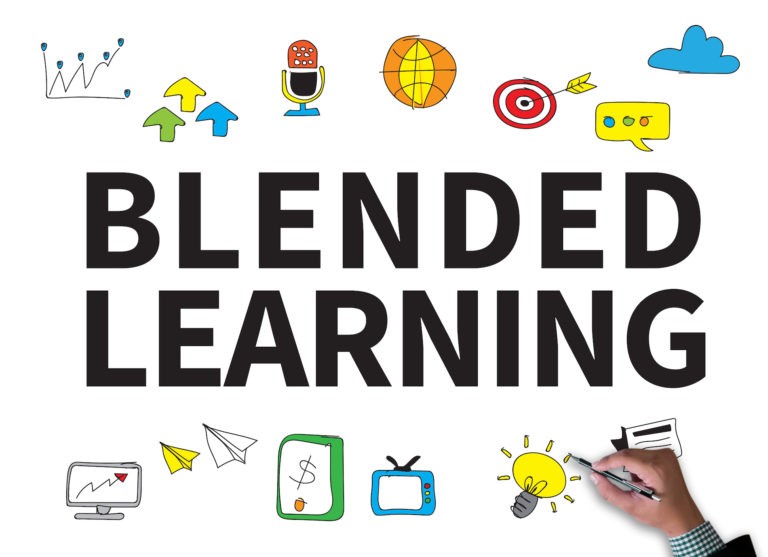March 17, 2020, was the ending of the longest running, most unchanged American system: Education. The entire traditional model was upended as brick-and-mortar buildings were closed indefinitely, and what the nation knew to be learning was changed within 72 hours. The soundtrack in the hallway changed to a monotone silence. The American school system changed.
Fast-forward six months and the preparation for the dawning of a new school year is approaching, and teachers are having to explore new models of learning as guidelines are enforced to maintain the health of our students and families.
What is Blended Learning?
Blended learning is an educational approach that has been used in pockets throughout our country’s classrooms, but, as an all-encompassing methodology, there is lack. Providing education in a mixed media format of brick-and-mortar attendance with online learning guided by teacher facilitation has been a buzzword embraced by few, misunderstood by many, but the driving force of a new era in education. Some characteristics of a blended learning model include the role of the teacher, physical location, personalization of the learning, and an online learning format.
Blended Learning Models to Try in Your Classroom
While thinking about the implementation of blended learning, it is significant to consider the different types of blended learning, how the learning is facilitated, and the developmental appropriateness for the age range you are instructing.
- Face-to-Face Driver
Using the face-to-face driver model has students located in a brick-and-mortar school building. Within the classroom, the majority of the instruction is provided by the teacher through an online platform. For instance, at High Tech High School in San Diego, California, a teacher may be instructing a small group of students around a concept, two students may be in a small group learning from ALEKS, and another group of students is cutting wood to complete their latest project. The teacher collaborates with the students to determine where they are in their project timeline and the instruction they need, then provides next steps.
Recommended Grades: K-12
- Online Driver
The online driver is completely online instruction, the curriculum and teacher are virtual; however, there is a mandatory face-to-face check-in. As a high school student, one may choose to dual enroll in college courses. For attendance purposes, the student may have to come to the school for an orientation and then they learn remotely for the remainder of the course, or there are outlined check-in dates with teachers to determine if the student is on track to receive credit for the course. We see this with virtual learning options across the nation today.
Recommended Grades: 11-12
- Rotation
In a rotation option, the students are placed in groups based on whatever criteria the teacher determines, and the students will rotate from center to center with at least one center providing online instruction. Most programs used in this format are adaptive to the students’ learning and regulates the zone of proximal development for students. Teachers will monitor student progress through the learning management system and can adjust learning objectives based on the feedback through formative assessment data analysis. While this is appropriate for all grade levels, it is a great option for elementary-aged students who may not have learned to manage large chunks of time spent in an online platform.
Recommended Grades: K-12, especially K-3
- Flex
Implementing the flex strategy includes primary online instruction with teacher facilitation. Imagine students in a computer lab, learning from an online platform. When the student gets stuck, there is a facilitator there to answer questions and provide instruction to assist the student within the online platform. Once a student has completed an assessment, the teacher would unlock the next unit or reset a test if the student didn’t meet a mastery level. Alternative schools use this model in order to accommodate a range of student grade levels and ability levels, providing maximum options for a student to be successful without being overstaffed with faculty. Alternately, when a student performs at high levels, flex provides students the opportunity to accelerate through their coursework, enriching their learning opportunities.
Recommended Grades: 5-12
- Online Lab
While online learning is a better option for some students, it is not a viable choice for working families when their child(ren) needs guidance and accountability when they cannot be home. In this case, an online lab may be the way to go. In an online lab, the student completes all work virtually with the benefit of supervision and assistance by a trained lab facilitator in a brick-and-mortar building. As a result, virtual learning labs have been created so students are enrolled in the school but all instruction is provided through an online platform.
Recommended Grades: 3-12
- Self-Blend
Students enrolled in middle and high schools are often working at varying levels. Through the self-blend model, the student may choose to take virtual courses to supplement their learning. Why would you do that? If the traditional school does not offer the course preferred or the student is on an accelerated path, this could be an option. These courses could also be zero-hour courses or after-school enrollments.
Recommended Grades: 9-12
Benefits of Blended Learning
Why should blended learning be an option? In today’s time of decreased budgets and high-stakes learning, blended learning provides options traditional models cannot. Blended learning allows teachers to meet students and families where they are and support student learning using innovative methods. Some of the clear benefits of blended learning include:
- Flexibility
- Cost-effectiveness
- Student success
- Efficiency
- Personalized learning
- Multiple learning styles
- Collaboration
- Networking




